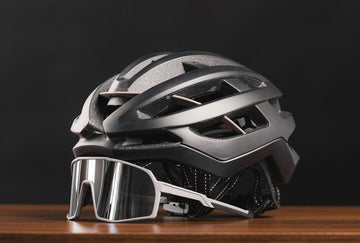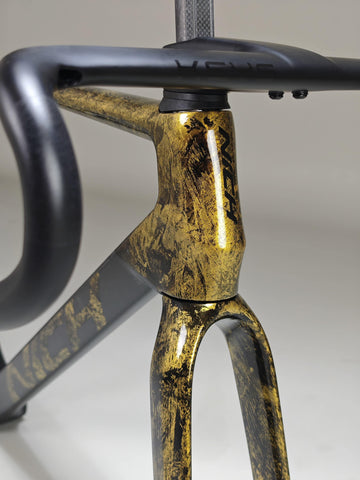Bike Helmet Basics: How to choose the right helmet

Recommended Gear for Better Riding
A bike helmet is the single most important piece of cycling gear for every rider. It can also be one of the most confusing pieces because there are so many different types and styles on the market. This article will help you find the type of helmet that suits you best. We also included some advice on how to fit your helmet correctly. But first the most important question: why is a helmet so important?
















Most important factors when choosing a helmet
- Protection
- Visibility
- Fashion statement
This is a question that almost every cyclist asks himself or herself when getting into cycling. A bike helmet protects your head by spreading the impact over a larger area. It can save you from serious injury but it does not in any way prevent accidents. The bike helmet should not be seen as protective clothing but as a safety device - and not just for training, this also goes for commute..
A road bike helmet differs clearly from a mountain bike helmet because it is designed for a completely different position on a bike and, obviously, for a much different speed. Using a mountain bike helmet for road cycling will make you slower and it can also cause some pain in the neck so make sure you choose the correct shape for the type of cycling you do.
expensive helmets do not always offer better protection
Expensive helmets do not always offer better protection as it is not so much about price. It`s the quality and comfort that really count. A good quality inner shell ensures good shock absorption while good ventilation makes sure that your head doesn't get too hot. A vent also allows the excess heat and moisture to escape so you don't have to wear a damp helmet in winter.
There are different types of helmets that allow you to choose according to your personal preferences:
- Road bike helmet: We know two main different types of road helmets. The first is “aero” and the second is “light”. The words suggest what is one or the other used for. Aero is a high-speed helmet that reduces drag and the ventilation isn't as good as in the “light” helmet which is usually lighter than “aero” and it has more vents for better breathability. Road bike helmets provide maximum airflow and comfort but they are not recommended for city cycling or other activities such as scooting, rollerblading, etc.
- MTB/BMX helmets: the design of these helmets is more focused on protecting your head from falling objects because these cyclists often ride in rugged terrain where branches and rocks are common hazards. There are two distinct features to easily recognize an MTB helmet. Lower back of the helmet and the visor in the front. And yes, the visor does make you slower.

Improvement of bike helmets and what are they made of?
- Expanded polystyrene (EPS)
- Hard shell top
The design of the bike helmet has changed a lot over time and is continuously improving. Most helmets have an outer shell that's made from tough plastic and a softer inner part with some padding. There are different types of inner shells for bike helmets to provide more protection from sharp objects. Helmets used to have thick foam pads covering every part of the head, but this has been replaced by multiple density liners which aim to reduce the bulkiness.
reducing the severity and consequences of brain injury up to 85%
Bicycle helmets can reduce the risk of head and brain injuries in case of an accident. They are effective at reducing the severity and consequences of brain injury by up to 85%. The most important piece of protective equipment for any cyclist!
Bike helmets come in different shapes and sizes, but the most important factor is always to get one that fits well. The best bike helmets are typically made of expanded polystyrene (EPS), a form of styrofoam. This is encased within an outer shell material such as plastic or carbon fiber. The styrofoam is designed to compress and absorb the force generated by an impact. It then spreads the energy into a wider area, reducing the amount of damage that occurs at one specific point on your head. For a helmet to be effective in protecting your head in a crash, it needs to fit snugly around your skull with minimal movement. A good bike helmet should be comfortable and the straps shouldn't pinch or rub. A hard shell can be damaged in a collision, so it needs to have an additional liner that absorbs impact forces after the outer shell has taken the brunt of the force. Helmets are generally made from expanded polystyrene (EPS), but some helmets use another type of foam called expanded polypropylene (EPP). These helmets are usually more expensive and weigh slightly more than EPS.

How to find the right fit for your head size?
- Try on several different helmets to find out what size suits you best
- If you find a comfortable helmet, check for these specific qualities:
it is light but not considered “the lightest”
are the straps tight enough? Remember, the beginning of the strap should be near your ear canal
- Pinch the front tip or back tip of your helmet to make sure it doesn't turn left or right. Use the retention system for better fit.
- Don't forget to check for a CE mark on your helmet! It ensures that you are buying a properly tested product
- Make sure you pick a helmet with reflective features. It increases visibility for you and other cyclists
- Remember: the most important piece of protective equipment for any cyclist is a high-quality cycling helmet.
- Final advice: When you put the helmet on your head you should not feel the helmet is "poking" you. Keep in mind that even "the best" helmets will not fit everyone

Approved helmet: AIR BENDER
- Colors: White matt, Grey matt, Black matt
- Fast buckle magnetic system
- ventilation system: 24 vents
- Front side built-in insect mesh
- weight: S/M 220g; M/L 265g; L/XL 280g
24 ventilation holes as well as 1 hole at the front with built-in mesh
The shape is designed for optimum protection- it's wide enough to cover the temples and squash the majority of your skull, as well as mash down your occipital bone at the back. It also has a polystyrene mesh liner so that doesn't get sweaty or uncomfortable as you ride. This helmet has 24 ventilation holes as well as 1 hole at the front with a built-in insect mesh. These features make this helmet not only safer but also more comfortable for you to cycle in.
The back of the Airbender is an amazing retention system, with an extra strap keeper above it which can be used to keep your straps out of your way if they're just dangling about during a ride. However, there are two additional straps at the back of the helmet which need to be taken into account when fitting. These two straps can be adjusted in length and played with until you get a fit where they feel comfortable and secure.
Cycling is a wonderful way to get exercise and enjoy the outdoors, but it can also be dangerous if you don’t take precautions. A bike helmet should always be worn for protection from falls or serious head injuries that could happen during an accident. The most important thing about finding a good fit is making sure it does not move around while wearing it so make adjustments as needed! If you find the right fit, remember that it’s always good to check for a safety standards certification. It ensures you are buying a properly tested product.

If you have any questions on the topic of cycling helmets let us know and we will be happy to advise you.
We offer a wide variety of different sizes and colors of cycling helmets which will suit most heads and complement every style.







